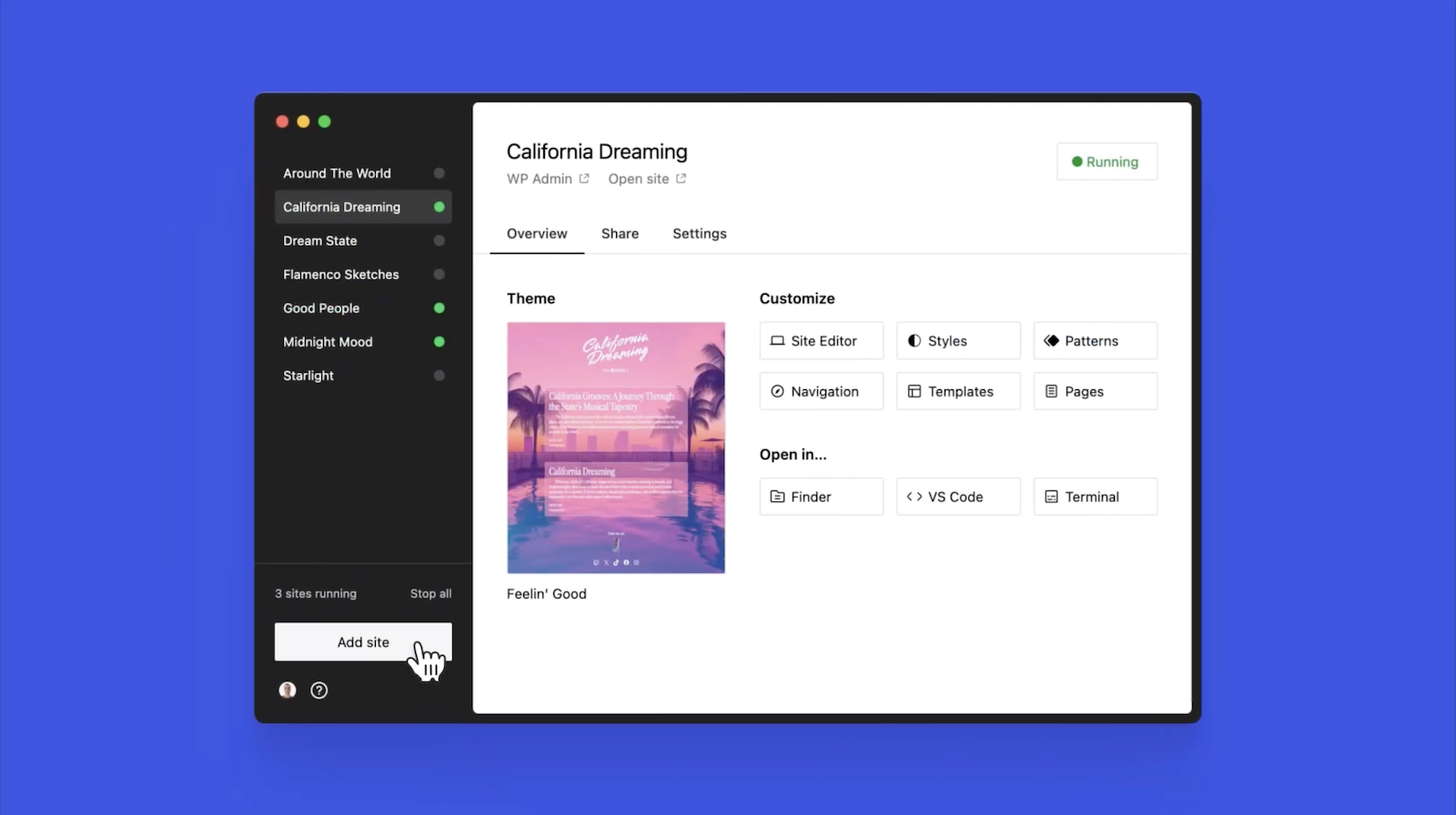Meet Studio by WordPress.com, our new, free, open source local WordPress development environment.
WORDPRESS
WordPress Is Turning 20, So Let’s Celebrate 20 Ways WordPress Has Evolved

Huzzah! WordPress, the world’s most popular content management system (CMS)—and our favorite, but we’re biased—celebrates the Big 2-Oh on May 27, 2023.
Launched in 2003 by Matt Mullenweg and Mike Little, WordPress has grown from a simple blogging platform to a powerful CMS that powers more than 40% of all websites on the internet today.
As WordPress celebrates its 20th birthday, it remains the driving force behind the democratization of the web and the empowerment of creators around the world. All this in mind, here are 20 examples and plenty of BIG numbers of how WordPress has evolved into the CMS legend we know and love.
WordPress by the (big) numbers
1. 43% of the known web relies on WordPress
It’s not even close: WordPress is the most popular content management system on the planet—by a factor of 10x. It’s no stretch of the imagination to say “WordPress runs the web.”
Source: colorlib.
2. 810 million websites run WordPress
You read that right: Eight hundred and 10 million and growing daily. WordPress “is here, it’s there, it’s everywhere,” to channel the chant by fans of the great footballer Roy Kent. Do we hear 1 billion coming into view soon?
Source: colorlib.
3. blog·o·sphere: WordPress.com users publish 70 million new posts every month
If you’re doing the math, that works out to about 1,600 new blog posts every minute or 26 per second.
Source: colorlib.
4. blog·o·sphere: 409+ million people view 20 billion+ pages on WordPress.com websites every month
Looking for meta-inspired reading suggestions? Check out this WordPress blog about WordPress blogs.
Source: colorlib.
5. 700+ sites get built daily on WordPress
Metrics like these confirm WordPress is not only the most ubiquitous CMS, but also the fastest growing. If you’ve read this far, you probably already guessed that.
Source: WordPress VIP case studies (via W3Techs).
But wait, there’s more…
6: WordPress owns 65% of the global CMS market
So much winning! If you’re keeping score—and we are—that’s 10x greater than WordPress’s nearest competitor. Even AI knows why WordPress rules—take it away, ChatGPT, but please channel actor Jeff Goldblum if you’re up to it:
Ah, WordPress. Yes, yes, yes. Well, it seems to me that WordPress has become quite the titan in the CMS market, hasn’t it? And why, you ask? Well, let’s take a closer look, shall we?
Firstly, WordPress is incredibly user-friendly. It’s intuitive and accessible, allowing even the most technologically-challenged among us to create beautiful, functional websites with ease. And who doesn’t love a little simplicity in their life, hmm?
Secondly, WordPress is highly adaptable. With a vast array of plugins and themes available, one can easily customize their website to their heart’s content. It’s like a chameleon, changing its colors to suit its environment. Fascinating, really.
And finally, WordPress has a vibrant and supportive community. People from all walks of life coming together to share ideas, collaborate, and create. It’s like a digital ecosystem, teeming with life and possibility. Oh, how I love the interconnectedness of it all!
So, there you have it, my dear friend. WordPress’s success is due in no small part to its user-friendliness, adaptability, and community. And who knows what other wonders it may bring us in the future?
Life, uh, finds a way, doesn’t it?
Sources: 10WebBlog.
7. 44% of the top 10,000 sites using a CMS are built on WordPress
From Disney, Sony, and the New York Times to a galaxy far, far away, this is the way… to CMS.
Source: Search Engine Journal.
8. 60,000+ free WordPress plugins
SEO to sitemaps, ecommerce to image compression creation, yeah, there’s a WordPress plugin for that. Like Contact Form 7 (perfect for managing multiple contact forms) and our own Jetpack (a must-have for security, backup, speed, and growth)—each with a mind-blowing 5 million active installations.
BTW: That 60K doesn’t even count the paid plugin side of things. If you’re on the hunt for the best plugins for 2023, let’s plug a few lists:
Source: WordPress.org plugins database.
9. 22,000+ WordPress themes
Ooh, you fancy! Themes help you modify the appearance of your WordPress pages with style, grace, and panache. At last check, there were ~11,000 free designs populating the WordPress Themes Directory, and another 11K on the paid side.
And here’s our curated in-house collection, from our parent organization Automattic. Rainfall, anyone? “… a clean, objective blogging theme strongly inspired by Swiss Design. Its minimalist functionality is balanced by a strong accent color, beautiful photography and post templates with sidebars.”
Open source and commerce
10: 90% of IT organizations use open source software within mission-critical workloads
Did someone say open source? It’s obviously a good thing, as open source software promotes collaboration, innovation, customization, cost reduction, and transparency, fostering a diverse and adaptable technology ecosystem.
Source: Ebow.
With that in mind, now may be a good time for an origin story.
WordPress isn’t a company. It’s an open source project, some might even say a movement, “supporting the idea of democratizing publishing and the freedoms that come with open source.”
This project, as opposed to commercial services built on top of WordPress, is often referred to as WordPress.org—the website where anyone can download the WordPress code. There is a vast community of contributors to the project, responsible for a plethora of plugins, themes, and other extensions used in conjunction with WordPress.
Learn more about the WordPress.org Mission and the Four Freedoms.
11. Cha-ching! Built on WordPress, WooCommerce owns 37% of the ecommerce market
Want to start selling online?
Check out built-on-WordPress WooCommerce, the world’s most popular ecommerce platform, now powering 164 million stores across the web. Simply install and activate the WooCommerce plugin on your WordPress website to turn it into an ecommerce machine.
As they say, “Launch in days, grow for years.”
Sources: colorlib.
Scaling for the enterprise
12. 2006: WordPress VIP is born
Recognizing the potential of WordPress at scale, Matt Mullenweg creates WordPress VIP to support the unique content needs of the enterprise. In fact, WordPress VIP was purpose-built for the highest volume, most security conscious, and most demanding digital properties.
If you check the web to learn about a major world news event, visit the website of one of the largest companies in the world, or access information from a government site, there’s a reasonable chance that WordPress VIP delivers the content you find.
13. 20 reasons to love WordPress VIP
If WordPress runs the web, WordPress VIP runs the enterprise web. A selection of capabilities and benefits might tell you why:
- Enterprise-grade, WordPress-based CMS with consumer-friendly content creation
- Flexible single-stack, headless, or hybrid architecture capable
- Platform support from the foremost WordPress experts
- Integrated GitHub repository and developer workflow
- Built-in Parse.ly content analytics and optimization
- Content-driven commerce with WooCommerce
- Containerized components and environment
- Agency and technology partner ecosystem
- Auto-optimized for performance
- Lightning-fast enterprise search
- Fully-managed site hosting
- Auto scaling infrastructure
- Enterprise-grade security
- FedRAMP compliance
- Salesforce integration
- Global infrastructure
- Intuitive visual editor
- Origin data centers
- Built-in CDN
- Lower TCO
We could go on…
Putting up big $ numbers
14. $202-$423B: WordPress customer revenue
Full disclosure: We like big $ numbers. Really big ones. Especially with Bs in them.
After crunching the numbers (and not really giving anything away), we derived this reported revenue range for the combined businesses operating on WordPress.com (our sibling, under the Automattic umbrella) and WordPress VIP.
“Not just for personal blogging…”
15. Breaking news: 44% of media companies on WordPress VIP earn $25M+ in revenue
We call that headline news worth shouting in ALL CAPS. Could it be how seamlessly WordPress VIP enables writers, authors, editors, journalists, influencers, and tastemakers to prepare and respond to breaking news events, engage audiences with personalized content, and know what topics resonate with their readers?
But wait, this just in…
16. In other news: 72% of non-media companies on WordPress VIP also boast $25M+ in revenue
Because high-growth companies everywhere feel the same growing pains: hard-to-use publishing tools, site infrastructure that wilts under traffic spikes, engineers worrying only about security instead of innovating.
Big names like Salesforce, Capgemini, OKdo, and others get it. That’s why they trust WordPress VIP, the most secure, usable, and reliable WordPress platform backed by support from the most experienced WordPress experts on the planet.
17. Number of $1B+ enterprises running with WordPress VIP: 148
It’s a case of “case closed,” don’t you think? It bears repeating: WordPress not only runs the web but the enterprise web as well.
Looking back, looking to the future
18. 3 big improvements WordPress VIP has driven to core WordPress
As noted by some of the team at the very core, so to speak, of innovation:
- “Elegantly extending WordPress to support enterprise customers who demand the most secure and performant version of WordPress that’s possible.” —Ryan Sholin, Head of Technology Partnerships, WordPress VIP
- “Helping WordPress grow from ‘just for blogging’ into a publishing platform for some of the largest, most iconic enterprises on the planet.” —Jason Hubsch, Support Engineer, WordPress VIP
- “Showing how WordPress can be scaled in both a secure and performant way to serve some of the most popular websites in the world.” —Raam Dev, Code Wrangler, WordPress VIP
Speaking of team and “it’s all in the family,” we’ve identified 30+ current or former WordPress VIPers who have directly contributed to WordPress core development since WordPress 3.2. Hats off to them for giving back to the Mother Ship! And that count doesn’t even include ongoing efforts such as translations, support forums, running meetups and WordCamps, and pitching in with various teams on Contributor Days.
19: WordPress VIP and FedRAMP compliance
Big Gov, Big CMS!
WordPress VIP is the only enterprise-grade WordPress platform with FedRAMP Authority to Operate (ATO).
Which is a shorter way of noting hyper-security-conscious government agencies and other businesses in high-risk agencies can take advantage of the flexibility, ubiquity, and ease-of-use of WordPress to create and publish content for their constituents and customers.
Going forward, workers at the largest public entities, from the halls of government to the launch pad, can finally start using the CMS they already know and love in their daily missions.
20. Designing better WordPress systems, for the ecosystem
Partnering with the best and brightest organizations in the WordPress VIP enterprise galaxy can’t help but inspire our future work in bringing together WordPress, systems, and websites.
Case in point: Figma, the popular collaborative interface design tool. Our integration work in helping keep design systems in Figma synced with WordPress themes is a textbook case study in taking WordPress to new frontiers and new audiences. And it’s just the start.
That’s a wrap, but we just can’t help but squeeze in one more way WordPress has evolved over the past 20 years…
Lucky 21. Better together—Parse.ly Analytics, WordPress… and AI
What’s the best way to understand content performance and prove the ROI of it… right… inside… WordPress?
Enter Parse.ly Analytics, which makes working with data easy for newsrooms and marketers, giving them the insights they need to focus their content strategy and prove ROI. After all, effective storytelling can’t happen without valuing and understanding both your content and your audience.
“Parse.ly brings you insights. It finds things for you,” notes WordPress VIP CTO Brian Alvey. “You don’t need to learn a new query language or dig through confusing screens. Creators love it because it tells them what to do next. Customers tell me it’s like ‘Google on steroids.’”
But, wait, that’s just the start. On our digital doorstep is the confluence of artificial intelligence, Parse.ly and WordPress, and a brighter future helping content creators make even more impactful content. Stay tuned.
So much to celebrate!
Now, head over to the #WP20 page for more 20th Birthday celebrations.
WORDPRESS
Your New Favorite Way to Develop WordPress Locally – WordPress.com News

Say goodbye to manual tool configuration, slow site setup, and clunky local development workflows, and say hello to Studio by WordPress.com, our new, free, open source local WordPress development environment.
We’ve built Studio to be the fastest and simplest way to build WordPress sites locally.
Designed to empower developers, designers, and site builders, Studio offers a seamless solution for creating and running WordPress sites directly on your local machine, as well as showcasing work-in-progress sites with your clients, teams, and colleagues.
Check out a few of our favorite features in the video below:
A new way to develop WordPress locally, available for free
Studio is now available to use for free on Mac*, and you can get up and running with a new local site in just a few minutes:
- Download Studio for Mac.
- Install and open Studio.
- Click Add site, and you’re done!
Once you have a local site running, you can access WP Admin, the Site Editor, global styles, and patterns, all with just one click—and without needing to remember and enter a username or password.
You can even open your local sites in your favorite development tools, such as VS Code, PhpStorm, Terminal, and Finder, making it even easier to add Studio to your existing development workflow.
Plus, Studio is open source; feel free to fork away on GitHub.
*A Windows version of Studio is coming soon, and you can request early access here.
Effortlessly share your work and keep moving forward
In the realm of web development, showcasing local work has often been a challenge when projects live solely on your machine. With Studio’s demo sites, you have a convenient, built-in solution for sharing your progress with your team, clients, or designers.
These publicly-accessible demo sites, hosted on WordPress.com, are a convenient way to share your work without the need for complex server setups or lengthy deployments. In less than 15 seconds, you can have a shareable link to your local site that stays active for seven days.
The best part? Demo sites can be refreshed to reflect your latest build, allowing you to easily convey any updates or changes!
Breaking free from traditional constraints
Unlike traditional local environment tools like MAMP or Docker, Studio takes a fresh approach to local WordPress development. Studio is a lightweight and efficient solution that minimizes overhead and maximizes simplicity by forgoing the need for web servers, MySQL servers, or virtualization technologies.
Behind the scenes, Studio uses WordPress Playground, the WebAssembly-powered PHP binary. Thanks to this technology, there is no need to use a traditional web server, making your development experience much quicker and smoother.
Say goodbye to complex setups and compatibility issues. Studio makes it easier than ever to build and manage WordPress sites locally.

Let’s get building
At WordPress.com, we’re committed to making your website management experience seamless. In the last few years alone, we launched staging sites with synchronization features, SSH and WP-CLI access, global edge caching, GitHub Deployments, and more.
Studio is yet another powerful feature to add to your toolkit. Stay tuned for more exciting updates, and remember to follow our blog to stay in the loop.
And, of course, download Studio today. Your local development workflow will thank you.
Major kudos to the Studio team on this launch! Antonio Sejas, Antony Agrios, Kateryna Kodonenko, Philip Jackson, Carlos García Prim, David Calhoun, Derek Blank, Siobhan Bamber, Tanner Stokes, Matt West, Adam Zielinski, Brandon Payton, Berislav Grgicak, Alexa Peduzzi, Jeremy Massel, Gio Lodi, Olivier Halligon, Matthew Denton, Ian Stewart, Daniel Bachhuber, Kei Takagi, Claudiu Filip, Niranjan Uma Shankar, Noemí Sánchez, and our beta testers.
Join 110.2M other subscribers
WORDPRESS
Smooth Transition: A Comprehensive Guide to Migrating from WooCommerce to Shopify

Are you considering migrating from WooCommerce to Shopify but feeling overwhelmed by the process? Fear not! This comprehensive guide is designed to walk you through every step of the migration journey, ensuring a smooth transition for your online store. Whether you’re looking to capitalize on Shopify’s user-friendly interface or seek better scalability for your growing business, this guide has covered you. Let’s dive into the essential steps and strategies for seamlessly migrating from WooCommerce to Shopify.
Understanding the Migration Process
Assessing Your Current WooCommerce Setup
Before embarking on the migration journey, take a thorough inventory of your current WooCommerce setup. Identify your products, categories, customers, and any customizations you’ve made to your store. This assessment will provide a clear roadmap for transferring your data to Shopify without missing any crucial elements.
Choosing the Right Shopify Plan
Shopify offers a range of plans tailored to different business needs, from basic to advanced. Take the time to evaluate your requirements and select the plan that aligns best with your budget and growth goals. Whether you’re a small startup or an established enterprise, Shopify has a plan to suit your needs.

Preparing Your Data for Migration
Backing Up Your WooCommerce Data
Before initiating the migration process, creating a backup of your WooCommerce data is essential. This ensures that you have a safety net in case anything goes awry during the transition. Export your product listings, customer information, order history, and other relevant WooCommerce data.
Importing Your Data into Shopify
Once you’ve backed up your WooCommerce data, it’s time to import it into Shopify. Shopify provides tools and apps that streamline the data migration process, making it easy to transfer your products, customers, and orders seamlessly. Follow the step-by-step instructions provided by Shopify to upload your data accurately.
Additionally, if you’re migrating from WooCommerce to Shopify, it’s crucial to understand the specific steps involved in this process. Ensure that you follow the recommended procedures and utilize the available resources to facilitate a smooth transition.

Designing Your Shopify Store
Choosing a Theme
One of the perks of migrating to Shopify is access to a wide range of professionally designed themes. Browse Shopify’s theme library to find a design that reflects your brand identity and complements your products. Whether you prefer a minimalist aesthetic or a bold, eye-catching layout, Shopify has a theme to suit your style.
Customizing Your Theme
Once you’ve selected a theme, customize it to align with your brand’s look and feel. Shopify’s intuitive drag-and-drop editor makes it easy to tweak your theme’s layout, colors, fonts, and imagery without any coding knowledge required. Experiment with different customization options until you’re satisfied with the overall design of your Shopify store.

Configuring Your Settings and Features
Setting Up Payment Gateways
Shopify offers a variety of payment gateways to accommodate different customer preferences. Configure your preferred payment methods, including credit cards, PayPal, Apple Pay, and more, to provide a seamless checkout experience for your customers. Ensure that your payment gateways are integrated securely to protect sensitive customer information.
Managing Shipping Options
Streamline your shipping process by configuring your shipping settings in Shopify. Set up shipping zones, rates, and fulfillment preferences to ensure accurate shipping costs and delivery times for your customers. Shopify’s built-in shipping tools make it easy to manage your shipping logistics efficiently.

Launching Your Shopify Store
Testing Your Store
Before going live with your Shopify store, thoroughly test its functionality to identify and resolve any issues. Conduct test transactions, navigate the checkout process, and review your store’s performance on different devices and browsers. Address any bugs or discrepancies to ensure a smooth launch for your Shopify store.
Announcing Your Launch
Once you’re satisfied with the functionality and design of your Shopify store, it’s time to announce your launch to the world. Generate excitement among your audience by promoting your new store on social media, email newsletters, and other marketing channels. Offer exclusive deals or discounts to incentivize customers to explore your new Shopify storefront.

Post-Migration Optimization
Monitoring Performance Metrics
After migrating to Shopify, monitor your store’s performance metrics to gauge its success. Track key metrics such as traffic, conversion rates, and average order value to identify areas for improvement. Use Shopify’s built-in analytics tools or integrate third-party analytics platforms to gain valuable insights into your store’s performance.
Continuously Improving Your Store
Optimize your Shopify store based on the insights gleaned from your performance metrics. Experiment with different marketing strategies, product offerings, and user experience enhancements to maximize your store’s potential. Continuously seek customer feedback and iterate on your store’s design and functionality to stay ahead of the competition.
Conclusion
In conclusion, migrating from WooCommerce to Shopify can be a manageable task. By following the steps outlined in this comprehensive guide, you can navigate the migration process with confidence and ease. From assessing your current setup to launching your new Shopify store and beyond, this guide equips you with the knowledge and tools to make a smooth transition. Embrace Shopify’s opportunities for scalability, flexibility, and growth, and watch your online business thrive in its new home.

Related
WORDPRESS
WordPress Block Patterns Give You Superpowers – WordPress.com News

Few WordPress features offer more return on your learning investment than block patterns.
With the power of block patterns you’ll be a WordPress superstar in no time, whether you’re an establish pro or just starting out. Block patterns are professionally designed layouts that you can add your site in a single click. What makes them especially powerful is that once they’re inserted, you can edit and customize every aspect. (Or, you can leave them be!)
In today’s Build and Beyond video, Jamie Marsland walks you through everything you need to go to become a block pattern expert, in under four minutes.
Get started on your site today with a free trial:
Join 110.2M other subscribers
-

 PPC6 days ago
PPC6 days ago19 Best SEO Tools in 2024 (For Every Use Case)
-

 MARKETING7 days ago
MARKETING7 days agoEcommerce evolution: Blurring the lines between B2B and B2C
-
SEARCHENGINES5 days ago
Daily Search Forum Recap: April 19, 2024
-
SEARCHENGINES6 days ago
Daily Search Forum Recap: April 18, 2024
-

 WORDPRESS6 days ago
WORDPRESS6 days agoHow to Make $5000 of Passive Income Every Month in WordPress
-

 SEO7 days ago
SEO7 days ago2024 WordPress Vulnerability Report Shows Errors Sites Keep Making
-

 WORDPRESS7 days ago
WORDPRESS7 days ago10 Amazing WordPress Design Resouces – WordPress.com News
-

 SEO6 days ago
SEO6 days ago25 WordPress Alternatives Best For SEO








![Astra Theme Coupon 2024 (Apr) [40% Discount, Save $400] Astra Pricing Plans on discounts](https://articles.entireweb.com/wp-content/uploads/2024/04/1713797772_611_Astra-Theme-Coupon-2024-Apr-40-Discount-Save-400-400x240.png)
![Astra Theme Coupon 2024 (Apr) [40% Discount, Save $400] Astra Pricing Plans on discounts](https://articles.entireweb.com/wp-content/uploads/2024/04/1713797772_611_Astra-Theme-Coupon-2024-Apr-40-Discount-Save-400-80x80.png)
![Elementor Pro Discount (Apr 2024) [70% OFF, Save $150] Elementor Coupon](https://articles.entireweb.com/wp-content/uploads/2024/04/1713729377_Elementor-Pro-Discount-Apr-2024-70-OFF-Save-150-400x240.png)
![Elementor Pro Discount (Apr 2024) [70% OFF, Save $150] Elementor Coupon](https://articles.entireweb.com/wp-content/uploads/2024/04/1713729377_Elementor-Pro-Discount-Apr-2024-70-OFF-Save-150-80x80.png)



